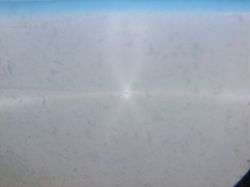Antisolar point


Photo: Francesco De Comité.
The antisolar point is the imaginary point on the celestial sphere exactly opposite the Sun from the viewpoint of an observer.[1] This means that the antisolar point lies above the horizon when the Sun is below it, and vice versa. On a sunny day, the antisolar point can be easily found: It is located at the shadow of one's head. Like the zenith and nadir, the antisolar point does not have a fixed position in three dimensional space, but is defined in relation to the observer: Each observer has their own antisolar point, which moves along with them as they change position.
The antisolar point forms the geometric center of several optical phenomena, including rainbows,[2] glories[3] and heiligenschein. Occasionally, during sunset or sunrise, anticrepuscular rays can be seen to converge at the antisolar point near the horizon.[4] This is an optical illusion, however, caused by perspective. In reality, the "rays" (i.e., bands of shadow) run parallel to each other.[5] Also, on a moonless night away from city lights, it is often possible to see the gegenschein at that point, arising from the back-scattering of light by interplanetary dust. In astronomy, when the moon or planets are in opposition, they are found close to the antisolar point.
Anthelic point
The anthelic point is often used as a synonym for the antisolar point, but the two should be differentiated.[1] While the antisolar point is directly opposite the sun, always below the horizon when the sun is up, the anthelic point is opposite but at the same elevation as the sun, and is therefore located on the parhelic circle. There are several halo phenomena that are centered on or converge on the anthelic point, such as the anthelion, Wegener arcs, Tricker arcs and the parhelic circle itself.[6][7][8]
See also
References
- 1 2 Tim Herd. Angular Measurements in the sky, excerpt from Kaleidoscope Sky, page 27. ISBN 0-8109-9397-X, Abrams, 2007
- ↑ Les Cowley. Primary rainbows - Atmospheric Optics, accessed 13 September 2013.
- ↑ http://www.atoptics.co.uk/droplets/glory.htm
- ↑ Les Cowley. Anticrepuscular rays, accessed 13 September 2013.
- ↑ http://www.atoptics.co.uk/fz892.htm
- ↑ Alexander Wünsche; Jim Foster, Anthelion and anthelic arcs, 2006
- ↑ Walter Tape, Atmospheric Halos, ISSN 0066-4634, ISBN 0875908349, American Geophysical Union, 1994, p. 27
- ↑ Les Cowley. South Pole Halos - Anthelic View - Atmospheric Optics, accessed 13 September 2013